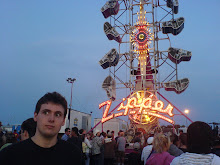Among the endless and inspiring mediums of the arts, all demanding your imagination, film and video (or more specifically moving pictures married to sound) are much akin to dreams themselves in how you experience them
.
(above: one of the many dreamlike sequences from Andrei Tarkovsky's STALKER)
Dreams are seemingly infinite experiences of the subconcious that can enfold in ways that seem totally out of place in our reality. But in the world of dreams, no matter how abstract things get, we can give ourselves to the experience. This is a train of thought that a non-narrative film often requires in it's viewing. A certain understanding that what you are watching, as Harmony Korine put it, "may not even be a movie."
(above: the mysterious "red room" from David Lynch and Mark Frost's TWIN PEAKS TV series)
Moving pictures accompanied by sound. Or maybe not. Stan Brakhage understood this, to me he is the epitome of non-narrative film. He would often literally paint each frame at a time by hand. He opted to leave out sound all together, perhaps so that we as viewers may accompany his visuals with any sound or music we choose. And some did choose:
(above: Sonic Youth guitarist Lee Ranaldo performing live scores to films of Stan Brakhage)
David Lynch likes ideas. He believes that any idea can be a worthy one, as long as it fits into the story and world you are trying to create. Truth is often stranger than fiction, who is to say that his movies don't fit like a glove? They sure feel like they do. We are left asking questions but deep down do we really want them answered? These questions are perhaps unanswerable. Like trying to speculate the meaning of a dream - you can only assume based on who you are at the time.
(above: a scene from David Lynch's bizarre RABBITS)
Harmony Korine believes that when you look at an old family photo album, the pictures of people and places, you can begin to fill in what is behind the photos. You can imagine the pain they must have been in when you see them with a broken limb, you can see the joy in the eyes of a family with a newborn baby. He believes that the medium of film can work in a similiar fashion. Exist perhaps as an artifact of times and places, emotions and people.
(above: a scene from Harmony Korine's utterly deranged TRASH HUMPERS)
Roger Ebert has written some very striking words on this subject in his review of David Lynch's MULHOLLAND DRIVE:
"There have been countless dream sequences in the movies, almost all of them conceived with Freudian literalism to show the characters having nightmares about the plot. 'Mulholland Drive' is all dream. There is nothing that is intended to be a waking moment. Like real dreams, it does not explain, does not complete its sequences, lingers over what it finds fascinating, dismisses unpromising plotlines. If you want an explanation for the last half hour of the film, think of it as the dreamer rising slowly to consciousness, as threads from the dream fight for space with recent memories from real life, and with fragments of other dreams--old ones and those still in development."
...
"This is a movie to surrender yourself to. If you require logic, see something else. 'Mulholland Drive' works directly on the emotions, like music. Individual scenes play well by themselves, as they do in dreams, but they don't connect in a way that makes sense--again, like dreams. The way you know the movie is over is that it ends. And then you tell a friend, "I saw the weirdest movie last night." Just like you tell them you had the weirdest dream."
(taken from http://rogerebert.suntimes.com/apps/pbcs.dll/article?AID=/20011012/REVIEWS/110120304/1023)
Narrative film has essentially remained the same since the days of D. W. Griffith's THE BIRTH OF A NATION nearly 100 years ago. Who has fun in a dream with all the answers? I prefer to wake up wondering what happened.
Conclusion: perhaps a direction the medium can further explore is that of one of lifes greatest mysteries: what is in a dream? Certainly I'm not the only one with these thoughts.
(above: a scene from my short film THIRTEEN-C)
